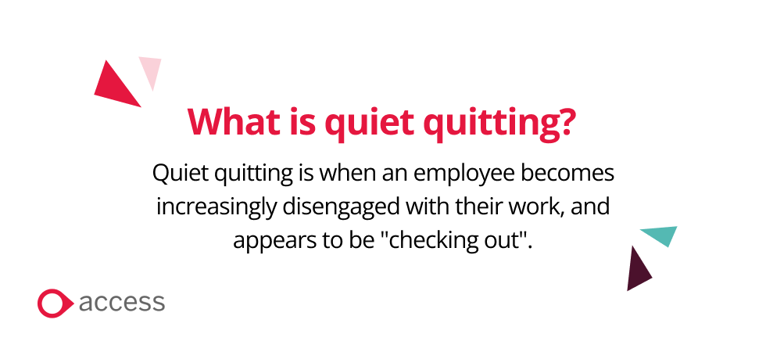
What is quiet quitting?
Quiet quitting is when an employee becomes increasingly disengaged with their work, andwork and appears to be “checking out”. Rather than a sudden resignation, quiet quitting represents a gradual withdrawal from the workplace. Employees continue to fulfil their basic job requirements but stop going above and beyond. They no longer volunteer for additional projects, participate actively in meetings, or invest discretionary effort into their roles.
This happens for a variety of reasons and often manifests itself as a lack of engagement and enthusiasm. What makes quiet quitting particularly challenging for organisations is its subtle nature. Unlike absenteeism or obvious performance issues, quiet quitting operates in a grey area. Employees aren't breaching any policies or failing to meet explicit job requirements. They're simply doing exactly what's asked of them. This makes it difficult for managers to address directly, yet the cumulative effect on team morale, innovation, and productivity can be substantial.

8 examples of quiet quitting in the workplace
It is important to spot the signs of quiet quitting in the workplace so the right support can be put in place, helping employees feel more connected to their work and the organisation. Managers are in the best position to see it as they know their teams best, but HR departments should also be prepared to provide training, information and strategies to help identify and deal with disengagement – and to prevent it in the first place.
How does quiet quitting manifest itself in the workplace?
- Less participation in meetings, particularly non-mandatory ones
- Greater absenteeism, which can often be linked to low motivation levels
- Unwillingness to take on additional tasks
- A lack of development or ambition to gain promotions
- Withdrawal from social team activities
- Turning down “stretch” projects outside of a job description
- A noticeable lack of engagement with work and the organisation
- Increasing occurrences of burnout or stress-related absence
Some employees may see these behaviours as a way of creating boundaries between their work and personal lives. However, these signs should always be taken seriously by employers as they can be indicative of poor mental health, wellbeing issues or wider problems with company culture. Every organisation is responsible for motivating and supporting their employees, which helps to build trust and engagement over time. With the right support structures, strategies, training and culture, quiet quitting is far less likely to become an issue.
Spotting these signs is the key to timely intervention. However, legacy HR systems often lack the tools to monitor subtle changes in employee behaviour. Discover why outdated software can make it harder to address disengagement before it escalates.

What is the impact of quiet quitting and how can you identify it?
Quiet quitting will look different depending on the employee, their attitude towards their work, their motivations and their ambitions. This can make it a difficult phenomenon to identify, which is why having the right tools, systems and training programmes in place will help.
These are some key ways to identify quiet quitting:
Good manager-employee relationships
Managers should have regular contact with their employees and should be trained to spot dips in engagement. Signs may be subtle, so building a good relationship and providing a platform to talk openly is very important. A disengaged employee may begin to withdraw from relationships they have built with both managers and other team members. According to Gallup’s State of the Global Workplace 2024 report, only 23% of employees worldwide are engaged at work, highlighting the importance of strong manager-employee relationships.
Employee feedback and surveys
These can be used to capture employees’ honest feedback, anonymously if you prefer. They may not be suitable to identify individual issues, but they can flag problems with engagement at an organisational level. Giving employees a voice to raise their concerns is extremely valuable. Surveys can be made up of multiple-choice questions, as well as open-ended questions that allow employees to document their opinions freely. Qualtrics’ Employee Experience Trends 2024 found that organisations using regular engagement surveys saw 24% higher employee satisfaction scores compared to those that surveyed annually.
You can also survey your employees during onboarding. These surveys can be useful tools for gauging and monitoring engagement. You can check out our Onboarding Survey Template for examples of what to ask your new hires.
Measurement of productivity and absence metrics
Employees who are psychologically disconnected from their jobs may be less productive when at work and could have higher absence rates. Monitoring these metrics continuously can help to reveal patterns, though bear in mind that there can be many other causes.
An employee in the early stages of quiet quitting might maintain their output levels whilst reducing their discretionary effort. Absence patterns can be more revealing, particularly when you observe changes in an individual's typical behaviour. However, approach these metrics with nuance. Increased absences might reflect genuine health concerns or burnout that requires support rather than scrutiny.
Profitability
When productivity decreases, reduced profitability can be a knock-on effect. Again though, remember that there can be many causes, so good analytics and HR input will be essential. Gallup’s research shows that businesses with high engagement achieve 21% greater profitability compared to those with low engagement. When multiple team members are disengaged, the cumulative effect can stifle innovation, slow decision-making, and create additional burden on engaged employees who compensate for their colleagues' reduced effort.
Performance management and appraisals
Beyond a strong employee-manager relationship, performance management should be formalised so that goals, achievements and overall contributions can be monitored over time. A strategic, proactive approach is important to spot dwindling engagement as early as possible. Regular check-ins – ideally monthly or quarterly – create opportunities for ongoing dialogue about workload, career aspirations, and support needs. The focus should be developmental rather than purely evaluative, exploring questions like "What aspects of your role energise you?" or "What obstacles are preventing you from doing your best work?".
Discover more ways performance management can be improved at scale in our article on performance management in enterprise teams.
Employee retention
While quiet quitting doesn’t necessarily mean that employees will leave the workforce, retention difficulties can be indicative of low engagement and weak company culture, so the two go hand in hand. Some quiet quitters do eventually leave, having mentally checked out long before they hand in their notice. However, in uncertain economic conditions, many disengaged employees remain in roles they've mentally departed because they don't feel they have better options available. This creates a challenging situation where organisations carry the cost of an employee who's no longer fully contributing, but that employee hasn't triggered the usual retention flags.
External reputation
With disengagement and retention difficulties often comes a knock to employer brand, making it harder to attract new talent in the first place.
HR software has a major part to play in helping to monitor the above metrics and identify levels of engagement and productivity. However, data will also need to be processed, interpreted and acted on. This can help to carve out an effective approach to strategic HR management, providing direction for future people strategies.
Expert Insight
In our Beyond Annual Reviews webinar, Emma Parkin, Head of Propositions at The Access Group explores how organisations can move beyond outdated processes to close skills gaps, boost engagement, and drive measurable business impact, including making an impact on quiet quitting.
Is there backlash against quiet quitting?
Some employers believe that quiet quitting can be indicative of a poor work ethic or even laziness. Harvard Business Review found that many have reacted negatively to the trend, arguing that an unwillingness to go the extra mile means putting the burden on others.
As with any over-simplified viewpoint, this interpretation should be treated with caution. When a phenomenon gets widespread attention and resonates with so many people, it’s important to consider why. What is it about the modern workplace that is driving these behaviours?
Workplace culture is incredibly important – 86% of job seekers avoid companies with a bad reputation and 88% say a healthy culture is essential for success. A toxic culture considerably narrows down the talent pool and makes recruitment harder, yet much of it stems directly from employer attitudes and expectations. Unrealistic expectations create a ripple effect through the entire workforce, frustrating and disengaging the exact people they are meant to motivate. iHire report that in 2025, 74.9% of employees said they’ve worked in a toxic workplace, and 78.7% of those blamed it on poor leadership.
How can you avoid quiet quitting in your organisation?
Preventing quiet quitting requires a proactive, multifaceted approach that addresses the root causes of disengagement rather than simply treating the symptoms. These are some of the key ways to overcome and prevent quiet quitting.
These are some of the key ways to overcome and prevent quiet quitting:
Engage managers
According to Gallup, only one in three managers are engaged at work, so solving engagement within management and senior leadership should be a priority. Only then can a positive company culture be developed, filtering down to all employees.
When managers themselves are disengaged, they're unlikely to notice early warning signs of quiet quitting in their teams, let alone address them effectively. Disengaged managers may inadvertently model the very behaviours organisations are trying to prevent.
Act on employee opinion
According to studies by Go1, 74% of employees are more effective at their jobs when they feel heard.
When organisations conduct engagement surveys or hold feedback sessions but fail to implement changes, this can worsen disengagement. Employees interpret inaction as evidence that their voices don't matter, reinforcing feelings of disconnection. Regular pulse surveys, one-to-ones, and feedback mechanisms only drive engagement when they're coupled with transparent communication about what's being done with that feedback. Even when employee suggestions can't be implemented, explaining why and offering alternative solutions demonstrates respect for their input and maintains trust.
Provide training
Even the most natural managers need training so they can support growth while preventing burnout.
Manager development had declined globally in recent years, and Gallups’s State of the Global Workplace 2025 Report found that only 44% of managers say they have received formal training. The most achievable avenue towards increasing engagement and productivity is for leaders to provide basic role training.
Training and development can be a really powerful tool to engage and demonstrate to employees that you care about their growth. With AI-enabled HR software, this becomes even easier, as Oli Quayle, Access’s AI Evangelist, notes:
“Pre-AI, to set up a whole learning course, to update materials, to set up that program—everyone thinks that’s massive, massive investment. But AI is great at taking large amounts of information, boiling it down quickly, and breaking it into pieces. So you can get really bespoke training courses that are fit for purpose and easy to update. When a regulation changes, you can just have it automatically update that stuff. So you can do it now at a scale that you could never do before.”
Episode 6: Future Proof Your People with L&D of Do the Best Work of Your Life
Set goals
Employees need a sense of purpose and fulfilment at work. Setting goals, both short term and long term, will support this and managers should be equipped to help their teams set achievable goals.
SMART goals in particular can have a positive impact on the engagement of employees; our article discusses how to integrate SMART goal setting into your performance reviews.
Clear goals provide direction and meaning, helping employees understand how their daily work contributes to broader organisational objectives. Without this connection, work can feel arbitrary or meaningless which can be a common precursor to quiet quitting. Effective goal setting creates milestones that allow employees to experience regular wins and progress, which sustains motivation over time.
Ensure wellbeing support is available
Creating a people-focused culture where employees are properly supported is both the right thing to do, and an essential facet of a high-performing workforce.
Wellbeing support needs to be accessible, visible, and genuinely embedded into workplace culture. Effective wellbeing support includes training managers to spot signs of stress or burnout, normalising conversations about mental health, and ensuring workloads are sustainable. It also means recognising that wellbeing encompasses more than just mental health – it includes financial security, physical health, and the flexibility to manage personal responsibilities alongside work commitments. When employees feel their wellbeing is genuinely prioritised, they're far more likely to remain engaged and invested in their roles.
Build a positive culture
Combat quiet quitting by creating a company culture that promotes engagement, support and wellbeing. This might include (but is certainly not limited to) offering flexibility, giving the option of hybrid work with more autonomy over schedules, providing training and finding out what employees really want and need from their work.
When developing strategies to build company culture, HR departments and management should be clear on their expectations of employees. A workplace that expects teams to go above and beyond, work long hours without additional compensation and give everything to their jobs without setting boundaries is much more likely to have issues with burnout and disengagement. Creating a culture of compassion and understanding where employees are supported and can raise concerns leads to better performance, a greater sense of belonging and improved engagement.
Read our blog to discover practical strategies to build and sustain company culture in large, distributed teams.

Tools to manage quiet quitting
Quiet quitting is new terminology for a well-known problem that has become even more prominent as employee values have shifted. Employers can turn it around or prevent it from happening by creating the right culture, but this doesn’t happen overnight. Tools and software should be fully utilised to track employee engagement over time and flag potential problems early. The right HR software can take care of everything from onboarding, to learning, to performance management, employee benefits and reward and recognition tools, all while providing comprehensive analytics. By continuously monitoring performance and engagement as well as putting steps in place to improve it, employers can achieve a competitive advantage.
These tools are crucial at the first stages of engagement with an employee, as the first impression is so important. Oli Quayle, AI Evangelist at The Access Group, explains how tools that are AI enabled, like PeopleXD Evo, can help you engage employees immediately:
“If you imagine that’s the first experience you have with a company—how they manage you as part of that workforce—and increasingly, the younger generation just won’t have it. It’s got to be mobile, it’s got to be quick, it’s got to be simple. And with generative AI and being able to pretty much converse with the computer, you don’t even need a front end to the workforce management system, because what you can do is you can chat to it. You can say, ‘What shifts are available next Tuesday?’ And instead of having to go to a cell in a field in a product, you can say, ‘Would you like me to book it for you?’ And you can say yes.”
Episode 5: Making workforce management work, Do the Best Work of Your Life
Stop quiet quitting before it starts.
Discover how Access PeopleXD Evo helps you boost engagement, streamline HR processes, and retain top talent.

 AU & NZ
AU & NZ
 SG
SG
 MY
MY
 US
US
 IE
IE

